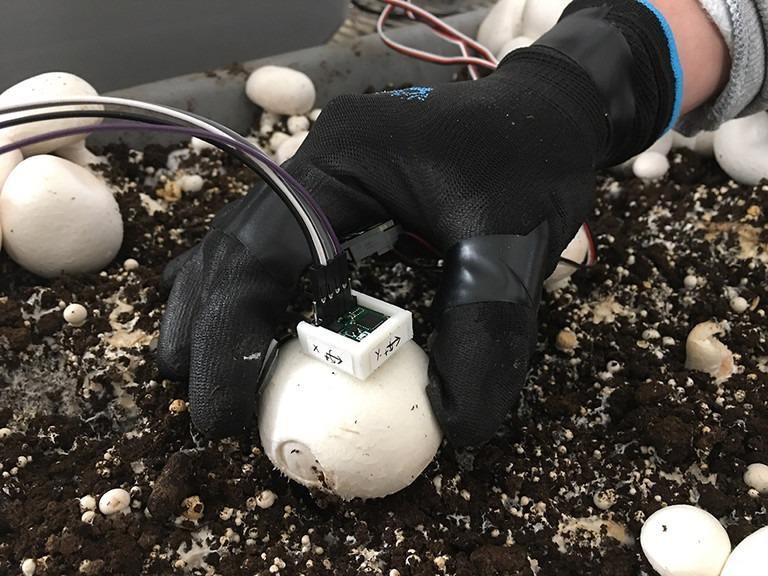Jun 2 2021
A new robotic mechanism has been developed by scientists from Penn State’s College of Agricultural Sciences for picking and trimming mushrooms. The team showed its effectiveness in the automatic harvesting of button mushrooms.
 To determine forces that needed to be programmed into the robotic picker, researchers took mushroom-picking-dynamics measurements using force sensors and an inertial measurement unit. Image Credit: Penn State.
To determine forces that needed to be programmed into the robotic picker, researchers took mushroom-picking-dynamics measurements using force sensors and an inertial measurement unit. Image Credit: Penn State.
As part of a new study, the prototype developed for integration with a machine vision system demonstrated that it has the ability to both pick and trim mushrooms that grow in a shelf system.
According to Long He, study lead author and assistant professor of agricultural and biological engineering, the study seems to be significant since the mushroom industry has been experiencing shortages in labor and increasing labor charges. Robotic or mechanical picking could be useful in mitigating those issues.
The mushroom industry in Pennsylvania is producing about two-thirds of the mushrooms grown nationwide, and the growers here are having a difficult time finding laborers to handle the harvesting, which is a very labor-intensive and difficult job. The industry is facing some challenges, so an automated system for harvesting like the one we are working on would be a big help.
Long He, Study Lead Author and Assistant Professor of Agricultural and Biological Engineering, Penn State
The button mushroom, also known as Agaricus bisporus, is considered to be an essential agricultural commodity. In total, 891 million pounds of button mushrooms prized at $1.13 billion were used up in the United States from 2017 to 2018.
As per the U.S. Department of Agriculture, out of this production, 91% were for the fresh market and were handpicked one by one to guarantee appearance, shelf life, and product quality. He noted that the labor charges for mushroom harvesting attribute for 15% to 30% of the production value.
He explained that a lot of hardships were involved in designing a device to harvest mushrooms effectively. While hand-picking mushrooms, a picker initially finds a mature mushroom and separates it with one hand, normally with the help of three fingers.
Additionally, a knife in the other hand of the picker helps eliminate the stipe end. At times, the picker keeps waiting until he gets two or three mushrooms in hand and cuts them one by one. Eventually, the mushroom is placed in a collection box. A robotic mechanism had to realize a comparable picking process.
The robotic mushroom-picking mechanism developed by the researchers contained a mushroom stipe-trimming end-effector, a picking “end-effector” with a bending motion, an electro-pneumatic control system, and a “4-degree-of-freedom positioning” end-effector for moving the picking end-effector. A laboratory-scale prototype was fabricated by the researchers to validate the mechanism’s performance.
The researchers employed a suction cup mechanism to latch onto mushrooms and performed bruise tests on the mushroom caps to examine the impact of air pressure and acting time of the suction cup.
The findings, published recently in the Transactions of the American Society of Agricultural and Biological Engineers journal, showed that the picking end-effector was positioned successfully to the target locations, and at the first pick, its success rate was 90%, which increased up to 94.2% after the second pick.
The scientists noted that as a whole, the trimming end-effector realized a success rate of 97%. The bruise tests showed that the air pressure was the principal factor that impacted the bruise level than the suction-cup acting time, and an improved suction cup might help decrease the bruise damage.
The laboratory test findings denoted that the developed picking mechanism can be applied for automatic mushroom harvesting.
For the study, button mushrooms were grown in tubs at Penn State’s Mushroom Research Center at the University Park campus. Experiments and fabrication were performed at the Fruit Research and Extension Center in Biglerville. In total, 70 picking tests were performed to assess the robotic picking mechanism. The working pressures of the suction cup and the pneumatic system were set at 25 and 80 pounds for every square inch, respectively.
The study involved other Penn State researchers: Daeun Choi, assistant professor of agricultural and biological engineering, and John Pecchia, associate research professor, Department of Plant Pathology and Environmental Microbiology.
The other research group members included doctoral students Mingsen Huang, from Jiangsu University, Zhenjiang, China; and Xiaohu Jiang, from Jilin University, Changchun, China, both visiting Penn State’s Department of Agricultural and Biological Engineering.
The study was financially supported by the Penn State Mushroom Research Competitive Grants Program.
Journal Reference:
Huang, M., et al. (2021) Development of a Robotic Harvesting Mechanism for Button Mushrooms. Transactions of the American Society of Agricultural and Biological Engineers. doi.org/10.13031/trans.14194.